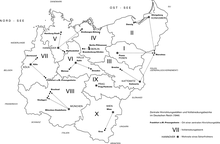Wilhelm Roettger
Wilhelm Friedrich Röttger (born March 6, 1894 in Hanover - Ricklingen ; † September 13, 1946 there ) was an executioner in Germany at the time of National Socialism , who from 1942 to 1945 in the " central execution site for execution district IV " (with the locations of prison Plötzensee and Brandenburg-Görden Prison ). More than a third of all death sentences were carried out here in the Third Reich.
Origin and professional career
Röttger completed an apprenticeship as a locksmith , then volunteered for the Navy and was deployed as a stoker on a ship during World War I. After the end of the war he couldn't find a job as a locksmith and from 1925 worked as a funeral assistant in Hanover.
Executioner in the Nazi era
In May 1940, Röttger succeeded Gottlob Bordt , who had been appointed executioner to Posen , and became the first assistant to the Hanoverian executioner Friedrich Hehr . When Hehr fell ill in November 1941, Röttger carried out a total of 26 executions in his place.
In June 1942 Röttger applied for the new position of executioner in Berlin. On September 23, 1942, he was appointed executioner of Execution District IV, which included the central execution sites in Berlin-Plötzensee and Brandenburg-Görden . He and his three assistants carried out several thousand executions, including the mass executions during the Plötzensee Bloody Nights in September 1943, when a total of 324 people were hanged. He carried out a number of death sentences against resistance fighters , such as on October 27, 1942, on Helmuth Hübener , who was only 17 years old , and also executed the resistance fighters on July 20, 1944 . In the Brandenburg-Görden prison, Röttger carried out death sentences every minute on August 21, 1944 under the direction of District Court Councilor Paul Wilbert .
Of the estimated 16,500 executed death sentences during the Nazi era between 1933 and 1945, 11,881 were carried out by the three executioners Johann Reichhart in Munich, Ernst Reindel in Magdeburg and Wilhelm Röttger in Berlin. Röttger carried out twice as many executions as Reindel and Reichhart together.
According to Harald Poelchau , Röttger lived on Waldstrasse in Moabit and, in addition to his work as an executioner, ran a large trucking business for the Berlin Central Cattle and Slaughterhouse . He looked like a “better gentleman” and was considered a “wealthy man”, while executioners usually came from the butcher's trade. Röttger is also said to have been "notorious for his rascals".
post war period
Röttger was discovered in 1946 in a hospital in Hanover , where he had fled. He died shortly after his arrest in Hanover prison on September 13, 1946.
See also
- List of people executed in the German Reich
- List of German executioners during the National Socialist era
literature
- Manfred Overesch : God, love and the gallows. Helmuth J. and Freya von Moltke in their last conversations in 1944/45. An essay. Helmuth J. Georg Olms Verlag, Hildesheim, Zurich, New York 2015.
- Harald Poelchau: The last hours. Memories of a prison minister. Berlin 1949.
- Thomas Waltenbacher: Central execution sites . The execution of the death penalty in Germany from 1937–1945. Executioner in the Third Reich. Zwilling Berlin, Berlin 2008.
Web links
- Matthias Blazek : Executioner of the years 1943–1945: Wilhelm Röttger. Accessed June 22, 2015.
Individual evidence
- ↑ a b Manfred Overesch: God, love and the gallows. Helmuth J. and Freya von Moltke in their last conversations in 1944/45. An essay. Helmuth J. Georg Olms Verlag, Hildesheim, Zurich, New York 2015. p. 129.
- ↑ Hans Halter : No Hitler salute at the place of execution . In: Der Spiegel . No. 8 , 1979, pp. 100 f . ( online ).
- ^ Petăr Stojanov: Reichstag fire - The trials in London and Leipzig. Vienna u. a. 1966, p. 320.
- ^ Peter Hoffmann : Resistance, coup d'état, assassination attempt - The fight of the opposition against Hitler. Munich 1979, p. 873.
- ^ Gerhard Keiderling: Berlin 1945–1986 - History of the capital of the GDR. Berlin (East) 1987, p. 380.
- ↑ Tankred Koch: History of the executioner - executioner fate from eight centuries. Heidelberg 1988/1991, p. 302.
- ↑ Harald Poelchau: From executioners and executioners. In: Structure. Cultural Political Monthly , ed. from the Cultural Association for the Democratic Renewal of Germany , 5th year, Issue 5, Berlin 1949, p. 28.
- ^ Peter Jokostra: Close contact. Hamburg 1965, p. 22.
- ↑ Max Frenzel, Wilhelm Thiele, Artur Mannbar: Busted Fetters - A report on the anti-fascist resistance and the history of the illegal party organization of the KPD in prison. Berlin 1976, p. 97. The date of death from: Manfred Overesch: The occupied Germany 1948–1949. Augsburg 1992, p. 812.
| personal data | |
|---|---|
| SURNAME | Röttger, Wilhelm |
| ALTERNATIVE NAMES | Roettger, Wilhelm; Röttger, Wilhelm Friedrich |
| BRIEF DESCRIPTION | German executioner |
| DATE OF BIRTH | March 6, 1894 |
| PLACE OF BIRTH | Hanover - Ricklingen |
| DATE OF DEATH | September 13, 1946 |
| Place of death | Hanover |
